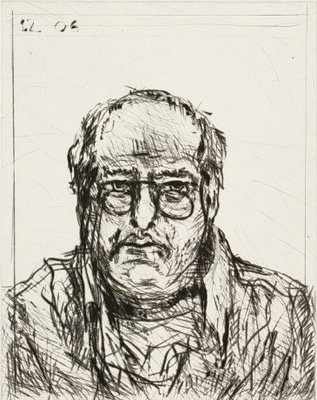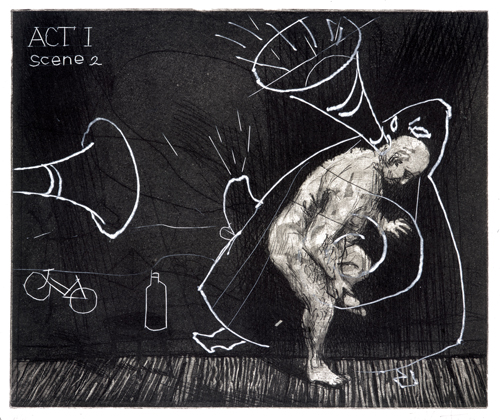“Anti-Entropy and Uncle Order”: A Dispatch from William Kentridge’s Sixth Norton Lectures
Over the past 6 weeks William Kentridge has shown the form of the lecture itself to be obsolete. But over the course of his returns to the podium, he has shown us that the lecture’s fate is not so dire as he had induced us —- for seventy minutes at a stretch -— to believe.
Here is the dispatch from Drawing Lesson One.
Here is the dispatch from Drawing Lesson Two.
Here is the dispatch from Drawing Lesson Three.
Here is the dispatch from Drawing Lesson Four.
Here is the dispatch from Drawing Lesson Five.
Drawing Lesson Six, “Anti-Entropy”
Introduced by Peter Galison, April 24, 2012
By Daniel Bosch
William Kentridge launched “Anti-Entropy,” his sixth and final Charles Eliot Norton Lecture, with a retelling of the story of Perseus, and doing so he gave back to his audience something with which it is already very familiar. His return to Greek myth to initiate his attempt to close his Six Drawing Lessons expresses something essential about them: Kentridge’s insistence on an open-ness to reconfiguration and reworking, the re-cognition of that which we have finished with yet cannot help our taking up again. And this insistence on doing-over expresses Kentridge’s deeply-held resistance to Fate. The lesson of Six Drawing Lessons is an injunction to return to the studio and to start again, an injunction to do precisely what Kentridge must now do.
In the context of “Anti-Entropy,” Kentridge gives the Perseus story back to us as a crucial site of frustration, a fructifying crux for the young artist. He remembers hearing the myth read aloud by his father in a train compartment. (See locomotive and linked car after linked car—like copies of each other —- chugging across the South African landscape, a foundational text of European civilization not quite baggage and not quite freight.) What about the myth exasperated young William? The urgent playing out of a gazillion contingencies in the lives of King Acrisius and his grandson, such that when the Perseus launches his discus it lands, as it must, on his grandfather, who is disguised in sack-cloth and ashes and has no idea where Perseus is but is killed by his grandson after all. Such fate drives young William bonkers. After all, in spite of all human desire, thought, effort, and passion, the hero’s fate, like his grandfather’s, is sealed.
I refuse to sum up either Kentridge’s work or these Six Drawing Lessons yet I maintain that both his practices and his principles draw from this childhood resistance to fate. Is it the fate of the Universe to move toward greater and greater disorder? Then I can get up every day and make espresso and push scraps of black paper (each was once a piece of a perfect rectangle) across a clean, white ground; I can record on film images of a woman throwing an over-sized mocked-up book against a wall —- and then play the record in reverse, to fix an axis of symmetry and appreciate her as a palindrome; I can mark white paper with charcoal, walk away, and come back to erase that mark and make another; I can enumerate once again the major indigenous uprisings against South Africa’s colonial power, as if they had been slated for a permanent forgetting; I can lecture on one sub-topic while film projected on a screen behind me depicts my own boredom with that discourse, or stare at a stubbornly blank pair of pages; I can orate on the common physical gestures associated with oratory while I perform those gestures; I can compare the ramification of electricity in a bolt of lightning to the ramification of trees’ limbs and roots. I can get up every day and make espresso in my studio and under its influence I can put things in order, and undo them, and put them into a slightly different order. I can put on black pants and a white shirt and I can make my art and so doing I can introduce into entropy bits of order. I can make my art that fails, most of the time, as all art must, because that is my fate and because my fate includes how I must resist it.
It will be an art historian of the future who ponders whether or not such a profound resistance to fate is more or less interesting because it informs the work a young white South African who lived to see his country, which had been written on black in white, re-volutionized, re-imagined, re-organized, re-started, its remarkable pieces re-vised, re-used, re-purposed. That art historian will have in the Charles Eliot Norton Lectures a resource, a place to seek an answer to the question. But these lectures won’t surrender it willingly. They are more rebus than dissertation, and their verbal and visual elements are ambiguous and poly-vocal. Fated to give six lectures, William Kentridge made six works of art, or one work of art in six movements.
Following “In Praise of Shadows,” the first work, which began with a retelling of Plato’s cave, I remarked on its promise -— that Kentridge’s Norton Lectures would be among the most exciting artistic events of the year. The work has exceeded that promise. Many who were lucky enough to hear some or all of these works wish they would just keep starting again, every Tuesday afternoon, ad infinitum -— that we could watch and listen to this magician for an endless semester. These works have left me feeling that most of what I know can and ought to be remade.
Art historians like Benjamin Buchloh (who introduced the second work) maintain that Kentridge takes up obsolete means of art production, and they rather grudgingly acknowledge that when his work is good its achievement comes at too high cost. Over the past 6 weeks Kentridge has shown the form of the lecture itself to be obsolete. But over the course of his returns to the podium, he has shown us that the lecture’s fate is not so dire as he had induced us —- for seventy minutes at a stretch -— to believe. There is only a very little heroism in smudging charcoal, in walking across a studio floor to snap the shutter twice; and returning to the paper mounted on the wall. But sometimes the man smudged with ashes is an animator, and sometimes the animator is a king.
When e.e. cummings gave the Norton Lectures sixty years ago, he called them “non-lectures,” but that did not mean that his presentations were continuous with his poetry — they originate from the prose world; they explicate, they argue, they expound. Now William Kentridge has failed to lecture in a new way. I went to the first lecture thinking, that in spite of a thousand disappointments, I more or less like lectures. Now I will never again sit through any such thing without recalling what happened six times in Sanders Theatre in Cambridge, MA, when Kentridge assembled so many fascinating, uneven, contingent, obvious, powerful, and sometimes logically flimsy but still convincing moments in works that constantly open up new topics, constantly return to and re-work topics animated moments or centuries before.
Part of my pleasure in attending five of these works and struggling to digest them here has been surprise at his agility and speed: I know he is only a series of still pictures, but in the zoetrope he spins Kentridge sprints, rolls, disappears, and reappears, always with his theme thrust an arm’s length above his head in victory or stuffed folded into his back pocket. Kentridge refused to give the Norton Lectures as he refuses to accept fate: by cleaving to his limited but real strengths, by not running away from what has been decreed. When he tossed Plato’s cave into the air, it fell to earth as Perseus’ discus, and Kentridge was there to catch it.
William Kentridge’s six Charles Eliot Norton Lectures are now complete.
They can be viewed online here.
The Charles Eliot Norton Professorship in Poetry was endowed in 1925 by C.C. Stillman (Harvard 1898). Incumbents are in residence through their tenure in the Chair, and deliver at least six lectures. The term “poetry” is interpreted in the broadest sense, to include all poetic expression in language, music, or fine arts.
Previous holders of the Norton Chair include Gilbert Murray (1926-27), T.S. Eliot (1932-33), Igor Stravinsky (1939-1940), Charles Eames ((1970-1971), Leonard Bernstein (1972-1973), Frank Stella (1982-84), John Cage (1988-89), Nadine Gordimer (1994-1995), and Orhan Pamuk (2009-2010).
Tagged: Antri-Entrophy and Uncle Order, Norton Lectures, Six Drawing Lessons



Daniel writes:
It will be an art historian of the future who ponders whether or not such a profound resistance to fate is more or less interesting because it informs the work a young white South African who lived to see his country, which had been written on black in white, re-volutionized, re-imagined, re-organized, re-started, its remarkable pieces re-vised, re-used, re-purposed.
And that historian will have your — and Gail Dane Mazur’s — report to help understand their reception at the time. Bravo to the Arts Fuse for re-cognizing (yes!) the cultural importance of these nourishing lectures which, in turn, have generated such nourishing conversation. As far as I am aware, there is no other outlet, in print or online, that has covered them with such depth, seriousness and delight.
And in the meantime, I’ve downloaded an image of one of Kentridge’s inky typewriters to display as a screensaver on my desktop.
This has been an exceptional series of dispatches, and I have enjoyed reading each one. Thank you!
Daniel, thank you for these dispatches. It was something extraordinary!
Yes, Kentridge, before our eyes, redefined the lecture form. It was a bright light shone in Cambridge these past weeks. I wept as he miraculously brought it back to the studio, to our shared experience of studio, where I think of these lectures as I circle. I want more, even as I digest these. I stand wowed and forever changed.